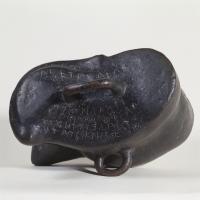Inscribed bronze weight in the form of a knucklebone
Inscription
Τάδε τἀγάλµατα̣
ἀπὸ̣ λείο Ἀριστόλοχος
[κ]α̣ὶ̣ Θράσων ἀνέθεσαν τ̣[ὠ]-
4 πόλλωνι δεκάτην· ἔχεε̣
δ' αὐτὰ Π(α)σικλῆς ὁ Κυδιµένε̣[ος].
These offerings, as a tithe on harvest?/booty?/unexpected gain?, Aristolochus and Thrason dedicated to Apollo. Pasicles, son of Cydimenes, cast them.
Inscription Credits
Ancient text after Rougemont, G. 2012. Inscriptions grecques d'Iran et d'Asie centrale, avec des contributions de Paul Bernard. Corpus Inscriptionum Iranicarum, part II, vol. I.1. London: no. 1. Reproduced by permission of Georges Rougemont and the Corpus Inscriptionum Iranicarum.
Comment
The five lines long inscription chiseled into the upper surface of the weight identifies this find from Susa as an ex-voto, offered to Apollo by two individuals, Aristolochus and Thrason, and cast by Pasicles, the son of Cydimenes. The names of both of the dedicants, as well as the name and patronymic of the founder of the weight are Greek.
Bernard Haussoulier first recognized the affinities of this Greek inscription with a group of analogous archaic dedications from the oracular sanctuary of Apollo at Didyma, within the territory of Miletus in western Asia Minor. He suggested that the weight must have been dedicated initially in the latter sanctuary. It would have been brought to Susa as loot following the suppression (ca. 494 BC) of the first Ionian uprising against the Persians and the subsequent destruction and plundering of Miletus and the Didymaion by Darius I's army (Hdt. 6.19). In this case, the expression of the identities of the two dedicants and the founder of the object without an accompanying ethnic would seemingly imply that all three individuals were citizens of Miletus. (See Haussoulier 1905 with pl. XXIX; Rougemont 2012: no. 1, with further bibliography.)
The object was solid cast, together with the handles, using the lost-wax process. Its weight of ca. 93 kg (or 6,645 Miletian staters) is compatible with the Milesian weight system (André-Salvini and Descamps-Lequime 2003: 18-21). To judge by the plural τάδε τἀγάλματα̣ (l. 1), which one might render in this context as 'these offerings' or 'these pleasing/beautiful objects', it probably belonged originally to a set of at least two (identical?) dedications.
At Susa, the weight was excavated in one of the trenches of the Mound of the Acropolis, hence, not in the palace area, but its actual context (a temple? storeroom?) cannot be ascertained (André-Salvini and Descamps-Lequime 2003: 21-23; Rougemont 2012: 23). One may assume that it was kept intact because of its symbolic value as a token of a Persian victory, although one cannot preclude a practical use, as a weight, since it was found alongside a Persian bronze weight in the form of a lion (Louvre Sb2718), which weighs about 120 kg or four Persian talents and was probably used as a standard measure (Lampre 1905: 171; André-Salvini and Descamps-Lequime 2003: 23-25).
Bibliography
André-Salvini, B. and Descamps-Lequime, S. 2003. ‘L'osselet de Suse: une prise de guerre antique.’ Actualité du département des Antiquités grecques, étrusques et romaines 10: 1-7.
Haussoullier, B. 1905. 'Une offrande à Apollon Didyméen.' In de Morgan, J., Jéquier, G., de Mecquenem, R., Haussoullier, B. and Graadt van Roggen, D. L., Recherches archéologiques. Deuxième série. Mémoires de la Délégation en Perse VII. Paris: 155-165.
Herodotus (Hdt.) = Godley, A. D. (trans.) 1920. Herodotus, The Histories. Cambridge. A searchable HTML version with commentary by Perseus Digital Library is available at http://www.perseus.tufts.edu/hopper/text?doc=Perseus:text:1999.01.0126
Lampre, G. 1905. ‘La représentation du lion à Suse.’ In Jéquier, G., de Morgan, J., Gautier, E., Lampre, G., Jouannin, A., Allotte de la Fuye, F. M. and de Morgan, H., Recherches archéologiques. Troisième série. Mémoires de la Délégation en Perse VIII. Paris: 159-176.
Rougemont, G. 2012. Inscriptions grecques d'Iran et d'Asie centrale, avec des contributions de Paul Bernard. Corpus Inscriptionum Iranicarum, part II, vol. I.1. London.
Cite this entry:
Zournatzi, A. 2016. 'Šuš (Susa): Inscribed bronze weight in the form of a knucklebone.' In Mapping Ancient Cultural Encounters: Greeks in Iran ca. 550 BC - ca. AD 650. Online edition, preliminary draft release. Available at http://iranohellenica.eie.gr/content/catalogue/sus-susa/documents/876144456





Bronze weight in the form of a knucklebone with Ionic dedication to Apollo. Mound of the Acropolis. Šuš (Susa), Ḵūzestān province, Iran. Sixth century BC. Excavations of J. de Morgan (Mission de la Délégation en Perse), 1901. Louvre, Sb 2719. H. 0.275 m, W. 0.39 m, Th. 0.245 m, Wt. 93.7 kg.